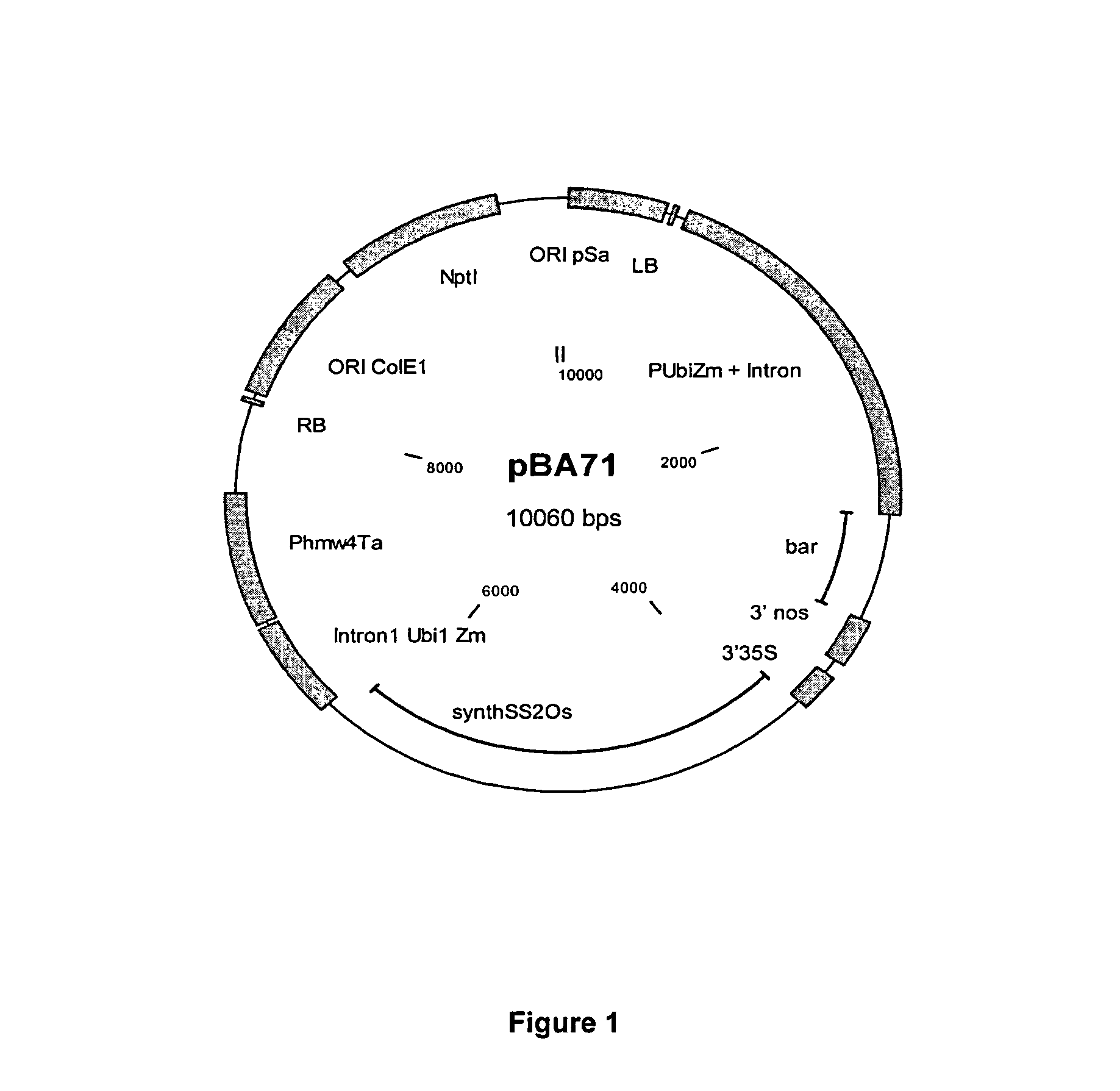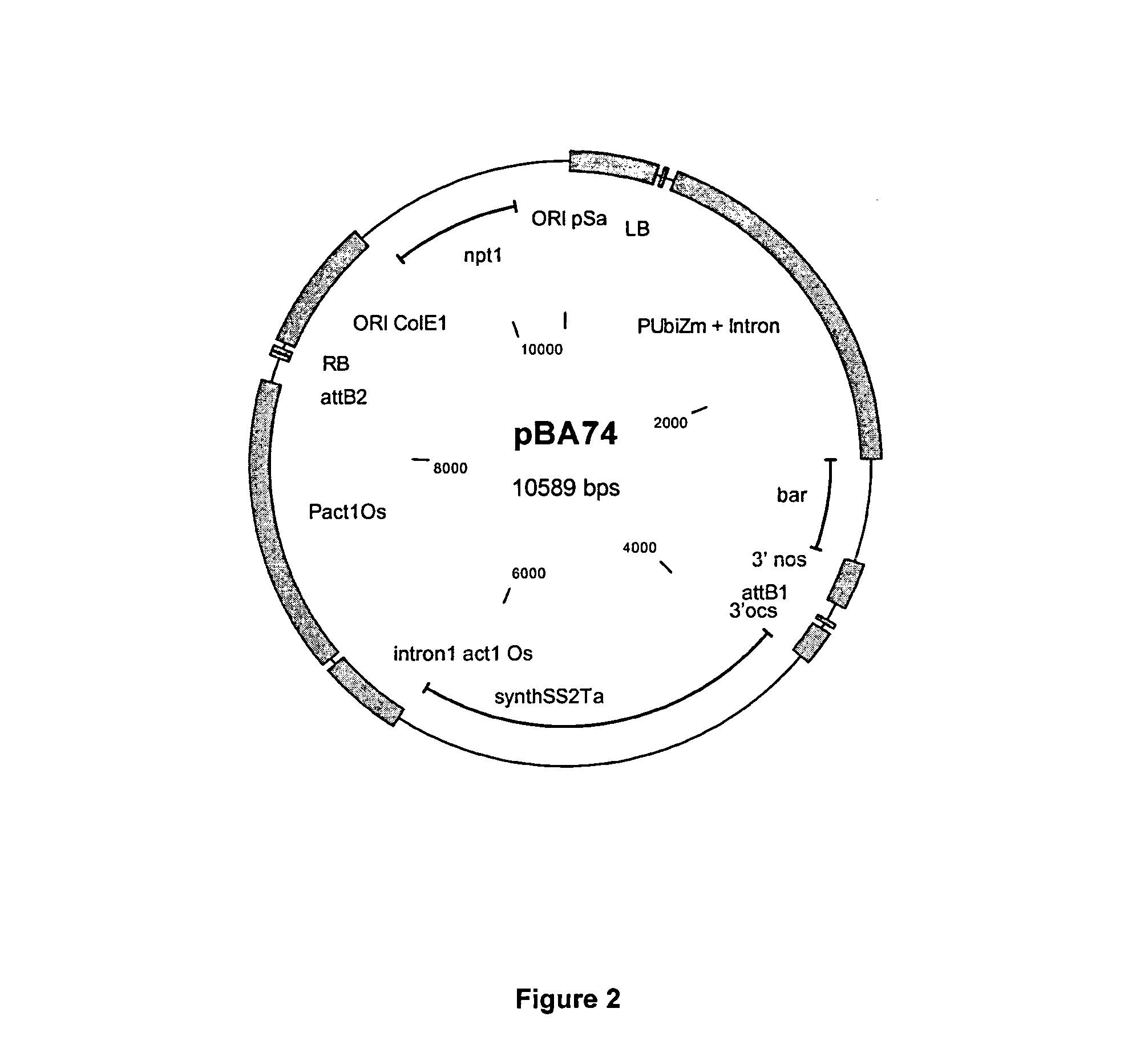Wheat starch and wheat flours and foodstuffs containing these wheat starch/wheat flours
a technology of wheat flour and amylose extender, which is applied in the field of wheat flour and foodstuffs containing these wheat starch/wheat flour, can solve the problems of low yield, expensive drying process, and starches from amylose extender (ae) mutants
- Summary
- Abstract
- Description
- Claims
- Application Information
AI Technical Summary
Benefits of technology
Problems solved by technology
Method used
Image
Examples
example 1
Preparation of the Vector pBA71 for Expression of a Synthetic, Mutagenized Form of the Starch Synthase II-3 from Rice (=synthSS2 Os mut) in Wheat
[0280]Functional Components of the Transformation Vector
[0281]The vector pBA71 is a derivative of the plasmid pGREEN (Hellens et al., 2000). The “backbone” of the plasmid contains the following functional components:
[0282][1] The “origin of replication” of the plasmid pBR322 (Bolivar et al., 1977) for replication in Escherichia coli (ORI ColE1)
[0283][2] A selection marker mediating resistance to kanamycin (nptI; Grindley and Joyce, 1980) for propagation in Escherichia coli and Agrobacterium tumefaciens.
[0284][3] The “origin of replication” of the plasmid pSA (Tait et al., 1982) for replication in Agrobacterium (ORI pSA)
[0285]The genetic components transferred into the plant genome are shown in the vector map (see FIG. 1) and described in detail in Table 1.
[0286]
TABLE 1Description of the genetic components which are inserted into the plantg...
example 2
Preparation and Identification of Genetically Modified Wheat Plants which Exhibit Increased SSII Activity
[0298]For the production of genetically modified plants with increased starch synthase II (SSII) activity, the T-DNA of the plasmid pBA71 was transformed by the method described in Wu et al. (2003; Wu H, Sparks C, Amoah B, Jones H D (2003) Factors influencing successful Agrobacterium-mediated genetic transformation of wheat. Plant Cell Reports 21:659-6686) by means of agrobacteria in wheat plants of the variety Fielder and then regenerated.
[0299]The rise in the SS2 activity of the transgenic wheat plants compared to the wild type wheat plants is demonstrated in zymograms.
example 3
Analysis of the Starches and Flours from Genetically Modified Wheat Plants which Exhibit Increased SSII Activity
[0300]The analysis of T1 grains was performed on the basis of pools from a small number of individual grains. The grain material was processed into wheat flours as described under Material and Methods and then used for the analysis of the amylose content, DSC properties, digestibility and the amylopectin side-chain distribution.
[0301]Flours from the wheat grains which contain the T-DNA for the expression of the mutagenized form of the starch synthase II-3 from rice (=synthSS2 Os mut; see SEQ ID No.3) exhibit an almost unchanged or slightly reduced amylose content compared to flours from non-genetically-modified wheat grains from wild type plants. The DSC temperatures of the flours from the transgenic wheat grains are up to 5° C. higher than those of the corresponding controls. Moreover, the flours from the transgenic wheat grains are more poorly accessible for degradation ...
PUM
| Property | Measurement | Unit |
|---|---|---|
| DSC T-onset temperature | aaaaa | aaaaa |
| DSC T-onset temperature | aaaaa | aaaaa |
| DSC T-onset temperature | aaaaa | aaaaa |
Abstract
Description
Claims
Application Information
 Login to View More
Login to View More - R&D
- Intellectual Property
- Life Sciences
- Materials
- Tech Scout
- Unparalleled Data Quality
- Higher Quality Content
- 60% Fewer Hallucinations
Browse by: Latest US Patents, China's latest patents, Technical Efficacy Thesaurus, Application Domain, Technology Topic, Popular Technical Reports.
© 2025 PatSnap. All rights reserved.Legal|Privacy policy|Modern Slavery Act Transparency Statement|Sitemap|About US| Contact US: help@patsnap.com



